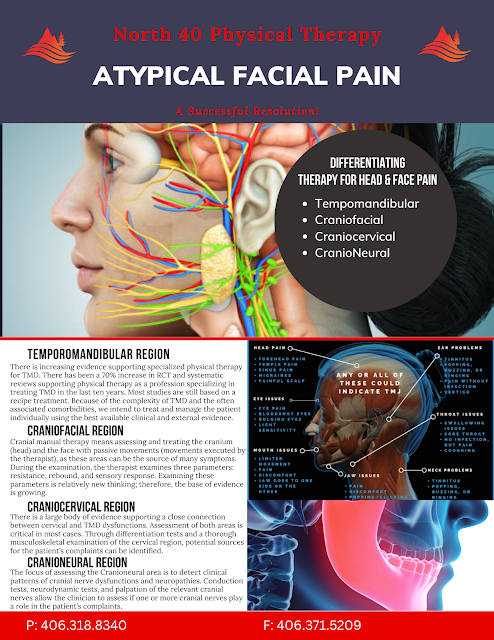Atypical facial pain, a condition characterized by persistent, unexplained facial discomfort (face, TMJ, headaches), can significantly impact an individual’s quality of life. Traditional treatments often focus on medication and psychological interventions, but there’s a lesser-known hero in the battle against atypical facial pain – physical therapy. In this blog, we’ll delve into the ways in which physical therapy emerges as a beacon of hope for those navigating the challenges of atypical facial pain.
Understanding Atypical Facial Pain:
Atypical facial pain is a complex condition that manifests as chronic facial discomfort without apparent organic cause or injury. The pain is often difficult to pinpoint and may not align with the typical patterns of other facial pain conditions. Individuals experiencing atypical facial pain may describe sensations such as burning, aching, or sharp pain, which can be both chronic and intermittent.
Traditional Approaches and Their Limitations:
Conventional treatments for atypical facial pain have primarily revolved around medications, including pain relievers and antidepressants. Psychological interventions, such as cognitive-behavioral therapy, are also commonly employed. However, these treatments may not always provide comprehensive relief, leaving individuals seeking alternative approaches to manage their symptoms.
How North 40 Physical Therapy Fits In:

Muscle Dysfunction and Tension:
Atypical facial pain often has a muscular component. Through thorough assessments, physical therapists identify muscle imbalances, trigger points, and areas of tension in the head, neck, and face. Targeted interventions, such as manual therapy and specific exercises, aim to alleviate muscle dysfunction, thereby reducing pain and discomfort.
Posture Correction:
Poor posture can contribute to facial pain by placing strain on muscles and nerves. Physical therapists work with individuals to correct posture issues, addressing contributing factors and promoting a more ergonomic alignment that can alleviate facial pain.
Joint Mobilization:
Dysfunction in the temporomandibular joint (TMJ) is often associated with atypical facial pain. Physical therapists employ techniques like joint mobilization to improve the function of the TMJ, relieving pain and restoring normal jaw movement.

Cranial compliance, the ability of the skull and its contents to adapt to changes in pressure, can significantly contribute to facial pain when disrupted. The cranium, a rigid structure housing the brain, is surrounded by various tissues, including membranes, blood vessels, and cerebrospinal fluid. Any imbalance or restriction in these components can compromise cranial compliance, leading to increased pressure within the skull. This elevated intracranial pressure can affect nearby structures, including the facial nerves, muscles, and temporomandibular joint (TMJ). The resulting tension and compression on these facial structures may manifest as atypical facial pain, characterized by sensations such as burning, aching, or sharp discomfort.
Nerve Desensitization:
In cases where nerve sensitivity contributes to atypical facial pain, physical therapists use desensitization techniques. These approaches aim to calm overactive nerves, reducing pain signals and promoting a more normalized nervous system response.
The cervical trigeminal nucleus plays a pivotal role in transmitting and modulating pain signals related to facial pain. Located in the upper cervical spine, this nucleus is an integral part of the trigeminal nerve pathway, which is responsible for conveying sensory information from the face to the brain. When there is irritation, inflammation, or dysfunction in the cervical spine, particularly in the upper segments where the trigeminal nucleus resides, it can result in aberrant signaling. This can lead to the perception of facial pain, even in the absence of direct facial trauma or injury. Dysfunctional signaling from the cervical trigeminal nucleus can contribute to the development of conditions such as atypical facial pain, where individuals may experience persistent and unexplained discomfort in the face. Understanding and addressing the role of the cervical trigeminal nucleus in facial pain is crucial for healthcare professionals, including physical therapists, in developing targeted interventions to alleviate symptoms and improve overall well-being.
Education and Self-Management:
Physical therapists play a crucial role in educating individuals about their condition and empowering them with self-management strategies. This may include exercises, relaxation techniques, and lifestyle modifications to help manage and prevent episodes of atypical facial pain.
Conclusion:
In the realm of atypical facial pain, North 40 Physical Therapy offers a multifaceted and patient-centered approach to relief. By addressing muscular dysfunction, improving joint mobility, and incorporating targeted exercises, physical therapists become instrumental partners in the journey toward managing and alleviating atypical facial pain. As with any healthcare approach, consultation with a qualified TMJ/craniofacial expert is essential to determine the most suitable and effective interventions for individual cases. Through the integration of physical therapy, individuals can find renewed hope and tangible paths to a life with reduced facial pain and improved well-being.